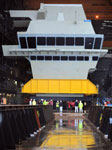
Upper Block 07
Remember when ships were built from the keel up and launched by sliding down the building ways into the water with a satisfying splash? OK, maybe I am showing my age. These days ships are built like LEGOs, massive LEGOs, of course, but still large blocks to be welded together to finally float gently for the first time in a drydock. The massive blocks don’t have to even be built in the same place.
This came to mind on seeing that the last structural block for the Royal Navy’s new aircraft carrier, HMS Queen Elizabeth, is being moved from the building yard to the assembly yard. The massive chunk of steel, piping and electronics is prosaically named, Upper Block 07, and contains the main bridge of the ship. The block will move by barge from the BAE Systems shipyard in Portsmouth, where it was fabricated, to the Rosyth Dockyard on the Firth of Forth in Scotland, for the final assembly with the rest of the ship. HMS Queen Elizabeth will be the first of the Royal Navy’s two new Queen Elizabeth-class aircraft carriers and is scheduled for sea trials in 2017 and flight trials in 2017. Thanks to Alaric Bond for passing along the news.

Sorry, but this is not something new.
The built the lake freighter The Roger Blough this way back in the late 60s or early 70s. Then the Lorain division of American Ship building went out of busniess around mid 70s. Ships got too big for the dry docs was a part of the reason.
More here: This large traditional styled Great Lakes self unloading bulk carrier was built in two sections as hull #900 by the American Shipbuilding Co., Lorain, OH for the USS Great Lakes Fleet, Duluth, MN at a cost of approximately $20 million. The keel of the 437 foot bow section was laid September 3, 1968 and was float launched December 21, 1968 (less ballast tanks due to the restricted size in width of the drydock). A new 125 foot wide drydock had been constructed where the keel of the 421 foot stern section was laid December 29, 1969. The bow section was floated into the new drydock July 25, 1970 and was joined to the stern section.
The official launch was scheduled for July, 1971 but a serious engine room fire on June 24, 1971 delayed the launch for almost a full year. http://www.boatnerd.com/pictures/fleet/blough.htm